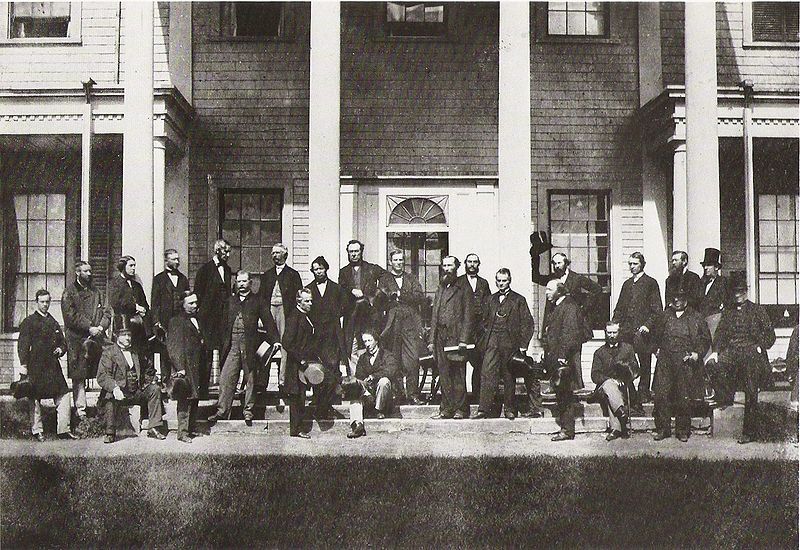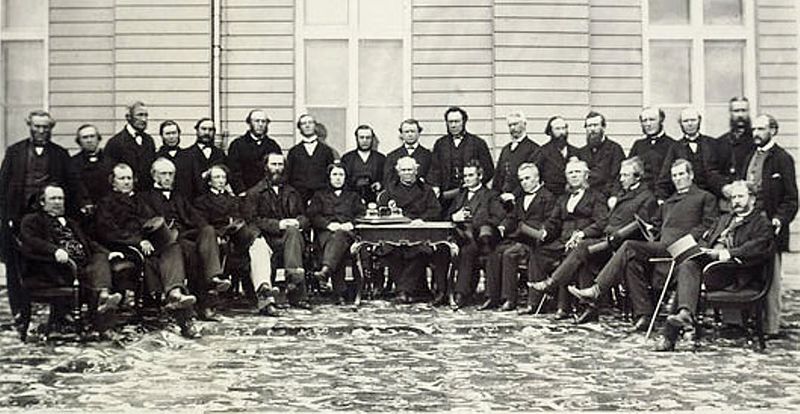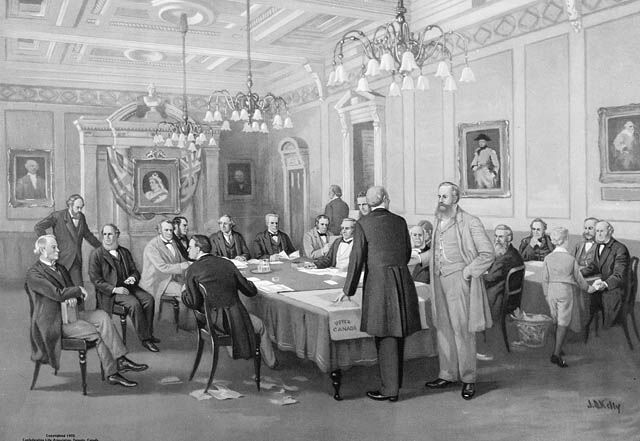In 1864, the potential end of the Reciprocity Treaty with the USA forced United Canada to seek out new trading partners. This situation, combined with various internal political problems, motivated the colonies to meet in order to find a long-term solution. It was suggested that a union between the colonies would strengthen their political and economic ties. To discuss this potential union, the representatives of the different regions attended a number of conferences.
The negotiations began in June 1864 in United Canada. George Brown, the leader of the Clear Grits Party, offered to partner with John A. Macdonald, the leader of the Liberal-Conservative Party from Upper Canada, and George-Étienne Cartier, of the Blue Party from Lower Canada. This partnership, called the Great Coalition, made it possible to form a government that held a majority of members in United Canada.
The members of the Great Coalition put forward the idea of forming a political and economic union with the other North American colonies. As part of a federation, this union would make it possible to form a larger economic unit and provide a better defence against the United States.
A federation is a union between several states or provinces. A central government is formed to make decisions for the whole territory. However, each province also has its own government, with its own powers.
Just like the politicians in United Canada, the maritime provinces were also planning to unite. To talk about this possibility, representatives from New Brunswick, Prince Edward Island and Nova Scotia met in Charlottetown from September 1 to 9, 1864. Some delegates from United Canada, including Brown, Cartier and Macdonald, managed to get an invitation to the meeting.
The representatives of United Canada used the meeting in Charlottetown as an opportunity to present their idea for a union between all the British colonies in North America. They tried to convince the other delegates that the plan was sound by mentioning, among other things, the construction of an intercolonial railroad that would benefit everybody. After much discussion, the delegates agreed on a project to form a federal union of colonies. They also decided to hold another conference in Quebec City the following month to discuss the details of the federation.

The Quebec Conference happened October 10 to 27, 1864, a month after the one in Charlottetown. The delegates from United Canada, Nova Scotia, New Brunswick, Prince Edward Island and Newfoundland attended in order to continue hammering out the plan for a federation.
The result of these conferences was that the delegates accepted the idea of a federal union and drafted a document called the “Quebec Resolutions” or the “72 Resolutions.” This document summarized the important points discussed during the conference and formalized the understanding between the colonies on the planned federation. Moreover, the delegates decided to use representation by population to determine the number of representatives for each province sitting in the Legislative Assembly. They also agreed on the construction of a railroad that would connect all of the provinces in the federation.

The 72 Resolutions drafted during this meeting would serve as a basis for the constitution of the Canadian Federation. The 33 delegates who attended the conference would be known as the “Fathers of Confederation”.
Although the members were called the “Fathers of Confederation,” Canada has always been a federation.
In a federation, a central “federal” government has different powers than the provinces. The central government delegates various powers to the provinces, which are not independent.
In a confederation, the different territories unite, but remain independent from each other. It is the states (called provinces in Canada) that grant certain powers to a central government. A state can withdraw from a confederation at any time. There are no longer any confederations anywhere in the world.
Before being submitted to the Parliament in London, the 72 resolutions had to be adopted by the Legislative Assembly in each of the colonies.
Prince Edward Island and Newfoundland decided to withdraw from the project. Given that these two colonies had far smaller populations, they considered that representation by population would give them less weight in the federal Legislative Assembly, which would be a disadvantage for them.
There were also many opponents of the project in Nova Scotia and New Brunswick. However, the promise of building a railroad enticed them to become part of the federation all the same. Nova Scotia voted in favour of the union in April 1866 and New Brunswick did likewise in June 1866.
As for United Canada, the project was warmly welcomed in Upper Canada, as representation by population guaranteed it a large number of federal members. In Lower Canada, opinions were split. Some believed creating a provincial government would allow them to better defend their interests. Others argued that they would be in a minority position at the federal level due to representation by population, resulting in less power, since their population was smaller than that of Upper Canada. In any case, the elected members approved the project in March 1865.
The final step before the union could become a reality was to present the project in London for approval by the Crown.
The delegates from the Province of Canada, New Brunswick and Nova Scotia met in London to start negotiations. The delegates created a bill based largely on the 72 resolutions drafted during the Quebec Conference.
The London Conference started on December 4, 1866, and lasted until March 29, 1867. It was on this date that the Canadian Constitution, called the British North America Act, was adopted by the British Parliament and the bill was accepted by Queen Victoria. On July 1, 1867, the federation became official and the Dominion of Canada, which combined Ontario, Quebec, Nova Scotia and New Brunswick, came into being.
